Spoilers For The Lord Of The Rings Ahead!
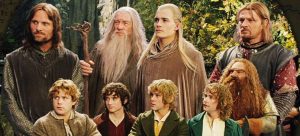
Happy Hobbit Day to all of my readers! Today, we celebrate the shared birthdays of hobbit heroes Frodo and Bilbo Baggins, chief protagonists of the fictional world of Middle-earth (you know, unless you’re counting the heroes of The Silmarillion, like Beren, Tuor, Húrin and Túrin, Lúthien Tinúviel, Eärendil, and so on). And because this is a movie blog, and not a book blog, I will be discussing The Lord Of The Rings movies rather than The Lord of the Rings novels in this post. Typically, I would only consider writing an extensively long post about a movie I disliked, but I have so much to say about these films, and so much of it is good (actually, almost all of it is good).
The Lord Of The Rings: The Fellowship Of The Ring, the first film in the classic trilogy, is the only one of the trilogy not to find a temporary home on Netflix this month, so you’ll have to purchase or rent it elsewhere if you want to watch it: here’s my review. I’m not going to be doing my usual hardcore fan-frenzy, where everything I write about the trilogy is unintelligible screaming, sobbing and wailing. Instead, I am going to write about the movie in a clear, concise way – with only a minimal amount of sobbing.
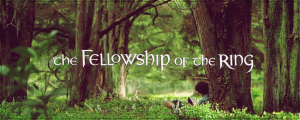
To understand The Fellowship Of The Ring, and its place of pride in modern film history, you need to understand what it was at the time it first released in theaters on December 19th, 2001. Nothing like it had ever been done before – and to this day it is still regarded as a monumental achievement. When New Zealand native Peter Jackson, best known for low-budget horror films (and putting Kate Winslet on the map with Heavenly Creatures), was put in command of The Lord Of The Rings trilogy, outside viewers were almost unanimous in their condemnation of the undertaking. It seemed impossible that someone with such an uneven and unpredictable track record of small-scale hits and misses could possibly succeed in adapting English author J.R.R. Tolkien’s massive fantasy novel to the big screen: Jackson wasn’t merely being asked to direct a film; he was being asked to helm a trilogy of massive three-hour long movies, which had to be shot simultaneously in his thoroughly unprepared home country, with a combined budget of $281 million dollars: a trilogy that was already a huge gamble for New Line Cinemas, after a tiresome war with Miramax for the film rights.
But instead of bowing to the insane pressure, Jackson and his crew rose to the challenge, turning the sleepy city of Wellington into a movie-making capital; transforming a rag-tag ensemble cast into award-winning celebrities; developing groundbreaking technology that had only been dreamed of previously, in order to perfectly realize the fantasy world of Middle-earth onscreen. From 1997 to 2004, Jackson’s team struggled against unimaginable obstacles, such as studio interference, harsh weather conditions, miscasting, injuries, and even burning birthday-cakes, to bring the series to the screen: with a vast fanbase of Tolkien loyalists watching their every move, sometimes literally spying on their filming locations, Jackson’s team were expected to deliver a final product that was faithful enough to the source material, while also making the film accessible to general audiences. The payoff was beyond rewarding: when Fellowship Of The Ring premiered, it was an instant box-office, critical and pop culture sensation, becoming the fifth grossing film of all time for a while, garnering a 91% Certified Fresh rating on Rotten Tomatoes and universal acclaim from critics, and being recognized as one of the greatest and most influential films of all time. It also significantly impacted the economy of New Zealand and made the country a flourishing tourist destination, so it can put that on its resume as well. And, looking at the bigger picture, it reshaped the entire fantasy genre, whether on the screen or on the page, for years to come: all of the dozens of fantasy adaptations coming out in the next few years owe something to Peter Jackson – largely because of his unprecedented decision to make Middle-earth feel like historical fiction, fantasy is no longer synonymous with the cheesy, exaggerated sword-and-sorcery movies of the 80’s and 90’s, but is instead one of the most revered genres of art in Hollywood today, and one that continues to rake in mountains of cash: so much so that Amazon Prime Video is making their own prequel to the series, which will be a similarly-daunting, if rather more organized, task – with a budget nearing $1 billion dollars, that series is expected to be the most expensive show ever produced: another win for the Middle-earth franchise that all began with Fellowship.
So why did Fellowship strike a chord with viewers, soften the harsh hearts of critics, and unite almost all book purists and revisionists in a shared love for Jackson’s vision? Because it’s a great movie, that’s why.
Fellowship is based on a novel, one of the best ever written (in my very biased opinion), and hews closer to the source material than either of its sequels, or the Hobbit movies which followed later. In Fellowship, we can see Jackson, still hesitant about making major changes to book canon, using what he has and expanding upon it with truly incredible results: there are few of the wholly new characters and subplots that emerged later – rather, there are small additions to the lore, minor alterations, and some significant divergences that feel entirely at home in Tolkien’s world, nonetheless. There are missteps, and I’ll discuss them, but for the most part Fellowship doesn’t just resemble the classic 1954 novel, but its story structure is strongly evocative of a novel’s pacing, and layout. Let us examine: Fellowship, the movie, is essentially split into three parts, each roughly an hour long.
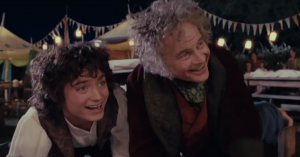
The first hour of the film is slow, laced with a brooding suspense: it builds up a mystery of epic proportions, but makes it feel small-scale and intimate at first, allowing us just enough time to get to know our team of furry-footed hobbit protagonists in the warm, hazy environs of Hobbiton – before upping the ante and slowly weaving more and more high-stakes danger into the mix: the One Ring, just a glimpse of gold; the namedrop of Sauron; hints of the miserable creature Gollum (Andy Serkis); all of this while we’re supposedly just enjoying a birthday-party with Bilbo Baggins (Ian Holm) and his large family of nosy busybodies, rosy-cheeked gardeners and Proudfeet. But the mystery is constantly boiling up in the background: it grows in size, soon ensnaring Bilbo’s nephew Frodo (Elijah Wood). Suddenly, cheerful Hobbiton is no longer bright and sunny: the lighting shifts, becoming moody and atmospheric, almost reminiscent of film noir; or maybe that’s just the giant smoke-ring clouds drifting lazily through the air. Half an hour in, and Frodo is on the move, after learning that he possesses the weapon of the Enemy. The music shivers quietly with anticipation, foreshadowing grander themes to come. We meet Frodo’s friends, Sam (Sean Astin), Merry (Dominic Monaghan), and Pippin (Billy Boyd). The Black Rider appears in the Shire, and nearly catches Frodo as he feels the temptation of the Ring for the first time. The wizard Gandalf (Ian McKellen) is captured by his nemesis, Saruman (Christopher Lee), and imprisoned in a vast darkness speckled with the fires of burning trees and the glow of underground forges. Frodo and company arrive in the town of Bree, hoping to find Gandalf waiting: but all they find are strange, watchful men and tidings of the Black Riders that have arrived before them. This first hour concludes with two major events: Frodo putting on the Ring for the first time and seeing the Eye of Sauron, his enemy, wreathed in fire, piercing through mind and flesh – and his meeting, immediately after, with the hooded ranger Strider (Viggo Mortensen), who offers to help him: and then, ever so gracefully, eases into the next hour with Saruman’s monologue about creating an army worthy of Mordor, an army of orcs and gnashing steel; while, imprisoned on the tower above him, Gandalf seeks a way of escape. That first hour could be an entire movie in itself, it’s so well crafted: building the mystery, heightening the tension, constantly keeping our protagonists on their toes, uncertain and doubtful of their choices, is a brilliant move.
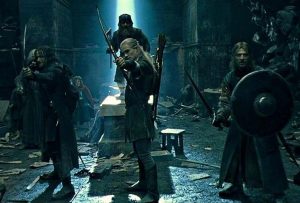
In the second hour, the mystery moves to the back-burner: the Ring, having done what it needed to do, is largely hidden away now, ever present but concealed, a lurking threat – delaying the inevitable, Frodo keeps it out of sight, but in those rare moments where it is revealed, the results are disastrous: the Witch-King is made aware of it, and stabs Frodo, nearly killing him; Bilbo sees it in Rivendell for only a moment, and nearly attacks Frodo in a blind rage at seeing it worn by another; Boromir (Sean Bean) sees it twice, and handles it once, and that is enough to drive him into torment and madness; it nearly destroys the Council of Elrond. But while it is not less of a threat, it is less obvious than those presented by physical enemies: the second hour opens with the battle on Weathertop, and moves on through an epic fight at the fords of Bruinen to the high and lofty citadel of the Elven folk: nothing is simple anymore, and the hobbits are out of their element, surrounded by characters who are almost archetypes – Strider’s real name is revealed to be Aragorn, and he sheds his well-worn gear for more noble attire: we learn of his lineage, and his chivalrous romance with Arwen (Liv Tyler), the Evenstar of her people. Gandalf escapes from Saruman’s clutches, riding a literal eagle, and soars across panoramic mountains. The mood and atmosphere change again, and the world seems bathed in light – the music swells and exchanges the domestic for the grandiose. We move through landscapes straight out of a nature documentary, and into the vast caverns of the Dwarves, realized in vivid CGI. But in this huge world, it is Gandalf who brings us back down to earth as the second hour closes, in his whispered conversations with Frodo in the Mines of Moria, and his heroic self-sacrifice to save the rest of the Fellowship of the Ring. Frodo himself is nearly killed by a cave troll, an innocent and pitiful creature deluded by the Ring into attacking Frodo. This foreshadows events in the third hour rather perfectly.
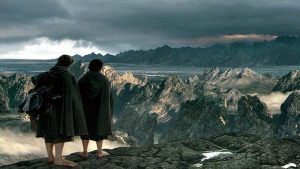
The third hour blends the suspense of the first with the epic action of the second, and delivers raw, emotional, character-driven drama: helpless after Gandalf’s fall, the Fellowship seeks refuge with the sorceress Galadriel (Cate Blanchett), but begin to split from within, as Boromir wishes to head back to his home country of Gondor – and it is now that the Ring suddenly reappears after its absence, haunting Frodo’s waking days and driving his friends mad with bewilderment: finally, when the Fellowship arrives at Amon Hen, it becomes too much for Boromir, who succumbs to the Ring’s allure and tries to take it from Frodo by force. Fleeing, Frodo stumbles in a blind panic, witnessing the devastating power he carries on a chain around his neck; he will destroy everything he loves, and everyone he cares about, if he does not act. Aragorn is almost tempted, and fights with his instincts for a few dreadful moments before letting Frodo go, and rejecting the Ring outright. At which point, I start crying, because this is when Boromir dies defending Merry and Pippin from Saruman’s orcs – the Chekhov’s gun that goes off with a fateful bang in the closing action sequence – and Frodo and Sam leave the Fellowship to continue the quest on their own. Hard choices have been made all around, the Fellowship is broken, hope is a faint glimmer on the edge of despair; and the movie is over.
There are minuscule flaws in those three hours of pure goodness, and they’re all nitpicks about diversions from book canon. For instance, something that constantly bothers me is the way that Barliman Butterbur looks over his shoulder at Aragorn when Frodo asks him about the strange man in the corner, instead of…(gets out battered copy of The Lord Of The Rings, flips to page 156)…“cocking an eye without turning his head.” Tolkien goes out of his way to mention that Butterbur doesn’t turn around, because Butterbur, the innkeeper, is already well aware of everybody in the place, who they are, and where they’re sitting, because he has to be. That’s the kind of thing that drives me insane in the movie. Nobody who hasn’t studied every page of the book would even notice this, but I have, so I do.
Anyway, the way that Jackson ratchets up the dramatic tension in this movie is insane, and the climax is rewarding and satisfying – and leaves you wanting more (thankfully, The Two Towers is just as, if not more, perfect in every imaginable way, shape or form). The choices he makes, centering the story around Frodo and his relationship with the Ring, giving both characters more agency in the story (for the Ring is a character), are brilliant. Even in that second hour, when Middle-earth suddenly expands from Hobbiton by the Water to a sprawling country of forests, mountains and scenic views, we are watching it almost always from Frodo’s point of view (the only real exceptions being Gandalf and Aragorn). And in Peter Jackson’s opinion, any scene in which the Ring is not the driving focus or at the very least an undercurrent is wasting time: which is why the hobbits’ whimsical escapades with Tom Bombadil in the Old Forest, a beloved part of the novel, was cut entirely from the films.
However, Jackson’s choice necessitated other changes to the source material, including one particularly controversial one: the characterization of Aragorn, one of the book’s noblest heroes. In Jackson’s films, in an effort to make Tolkien’s archetypal protagonist more sympathetic to mainstream audiences, and also to make the Ring even more powerful, Aragorn’s character is softened somewhat, and given a full character-arc – raised by the Elves under the care of Elrond (Hugo Weaving), Aragorn feels more at home with them than with his own people; weak, easily corruptible Men. In his veins runs the blood of Isildur, the man who fell victim to the Ring’s temptation thousands of years before and bound his descendants to the Ring’s fate – Aragorn’s distrust of himself, and his doubting of his own strength, is a key element of his character in the films, and it is what drives many of his actions: from his dangerous romance with Arwen, to his decision, at the end of the film, to resist the Ring and in so doing save both Frodo’s life and his own.
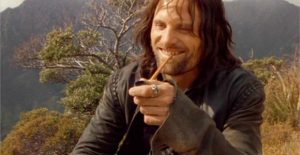
Viggo Mortensen, thankfully, is a phenomenal method actor, and does a great job portraying the Ranger’s conflict. It is rather unfortunate that the screenwriters felt, going forward, that his character needed to be constantly elevated to the detriment of others, and, in The Hobbit, tried to copy-and-paste him over the character of Bard the Bowman. But it is understandable, when watching Fellowship, why they became so obsessed with him. I would even go so far as to say that Mortensen is the film’s MVP, bringing roguish charm, grace, dignity and his unique accent to every scene he’s in – he plays Aragorn’s internal conflict subtly, using small facial movements (and his wildly expressive eyes) to display unease.
Similar praise can be lavished on Elijah Wood and Ian McKellen, but not, unfortunately, Sean Astin: his portrayal of Samwise Gamgee is consistently one of my least-favorite things about the trilogy, unpopular opinion though that may be. Some of it may be attributable to Jackson’s directing, but Astin’s tendency to shout lines that don’t need to be shouted, or become exaggeratedly happy or sad, begins to make him look like a parody of the over-the-top animated Samwise in Ralph Bakshi’s 1970’s The Lord Of The Rings. He rescues himself in his final scenes with Frodo, but just barely.
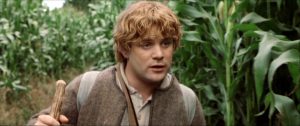
For the most part, the ensemble cast is very good: Sean Bean’s Boromir is sympathetic and pitiful; Holm, Weaving and Blanchett are endearing glorified cameos; Orlando Bloom as Legolas is decent, if a bit wooden; the only truly miscast character, in my opinion, is the Dwarf, Gimli. It’s not that John Rhys-Davies does a bad job in the role (how could he?), but the role itself should never have been tailored for an actor like him: in the novels, Gimli is proud, noble and mysterious until he begins to warm up to his traveling companions, and even afterwards he is still distinctly unusual to them, a bit of an underdog. In the movies, he’s brash, reckless and foolhardy, talks far too much, and is constantly the subject of unfriendly jokes (including the notorious “Nobody tosses a Dwarf!” punchline that continues to infuriate book purists to this day). If The Lord Of The Rings had been made after the Dwarf-centric The Hobbit, I think Jackson and his team would have been aware of this and would have cast someone more like Richard Armitage, their Thorin Oakenshield, in the role: but it was not, they did not, and we got Rhys-Davies.
The talent behind the camera deserves a special shout out. Peter Jackson, Fran Walsh, and Philippa Boyens put together an incredible, multi-faceted script that is true to the spirit of Tolkien’s work (despite the fact that neither Jackson nor Walsh had been fans of the book before starting the project) and makes for an excellent movie even viewed on its own. The film’s cinematography is absolutely brilliant – and Academy Award winning. Ngila Dickson’s costume department outfitted the Fellowship and their supporting cast perfectly (another special shout-out goes to Viggo, who insisted on wearing his Aragorn costume while hiking in the wilderness, sleeping in it, and even mending it to give it a more weathered look: did I mention he’s a method actor?). Weta Workshop designed countless weapons, prosthetics, miniatures, and props under the direction of Richard Taylor, and the now legendary craftsman Jens Hansen was commissioned to create the One Ring itself. Art directors John Howe and Alan Lee brought unique visions to the world-building of Middle-earth. Howard Shore composed a brilliant and emotional score for the film that is widely considered one of the greatest ever, while New-Age singer Enya lent her powerful vocals to the film’s iconic Elvish ballad, “May It Be”. The New Zealand government (both local and national) and army helped Jackson to build sets and gain access to filming locations, provided hundreds of extras, and later promoted the films with every available resource. The thought and care that went into every inch of film, fabric, concept art, set design, stunt-work, music and CGI is incredible.
And, while I’m busy writing this lengthy Oscar-acceptance speech for Peter Jackson, I may as well take a moment to honor the lasting legacy of J.R.R. Tolkien, the father of modern fantasy, whose story lives on through his novels, and through the succession of films, radio dramatizations, streaming shows and biopics that have followed. Say what you will about Peter Jackson’s decision to cut out Tom Bombadil, or give the Balrog wings, or the “dumbing down” of the author’s philosophical and pseudo-religious views, the truth is that his movie has taken Tolkien’s original message and spread it to an even wider audience. Sales of the novel skyrocketed in the wake of Fellowship‘s release. Tolkien became a household name for people who had never even considered reading one of his books.
Granted, there are still the poor, naive souls who think that Tolkien is “that guy who ripped off J.K. Rowling”, but it’s best to just ignore them.
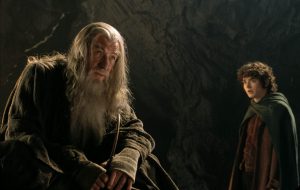
Tolkien’s message in Fellowship is essentially the same from page to screen: he tells us that our lives are built around choices, especially hard and uncertain ones; choosing between right and wrong, between an easy way and a hard way, or worse, two difficult paths that lead to an unclear future. They are the choices we all make – the choice to adapt a 1,000 page novel into a three-part movie series, the choice to simply walk into Mordor with your gardener and a weapon of mass destruction, and….wait, you’re telling me you’ve never had to make those choices? Anyway, Fellowship is not a happy story, and it does not end happily for any of its heroes: sometimes, the choices we make have real, lasting consequences, and they’re not always good. But it is not an unhappy story either. It is about free will, and about the human privilege of being able to make decisions for ourselves: what a gift that is, that we take for granted! When Gandalf told Frodo, in the long dark of Moria, that “All we have to decide is what to do with the time that is given to us,” he spoke truly – we are granted a brief time on this earth to do something great, and to leave a legacy behind us. But choosing to do that is up to us.
And as for Peter Jackson? Well, he’s already done it.
Movie Rating: 10/10